FutureProof is a collaboration between HuffPost and Unearthed, Greenpeace UK’s journalism unit
Earlier this year, Americans learned what it looks like when a food system reliant on industrial agriculture, near monopolies and exploited laborers breaks down.
Just two months into the pandemic, the meat industry in the most powerful nation in the world was buckling.
In March and April, COVID-19 swept through meatpacking plants, infecting thousands of workers. In Colorado, an outbreak at a huge JBS beef processing facility killed six workers. In South Dakota, as cases surged in a Smithfield pork plant, officials offered bonuses to employees who kept coming to work (although the company said any worker missing work due to COVID-19 exposure or diagnosis would still get the money). By November, more than 11,000 Tyson Foods workers had been diagnosed with COVID-19 ― 9% of its total workforce.
“It was like drinking out of a fire hose,” said reporter Leah Douglas, who began tracking COVID-19 outbreaks across the food system in April. “The pace of the spread was so intense.”
On April 22, Douglas published the first version of a map with approximately 40 outbreaks. Now, the map blooms with orange, blue and pink bubbles, a visualization of the more than 73,600 COVID-19 cases and 336 deaths among food sector workers. Meatpacking workers have accounted for more than 49,000 of those cases.
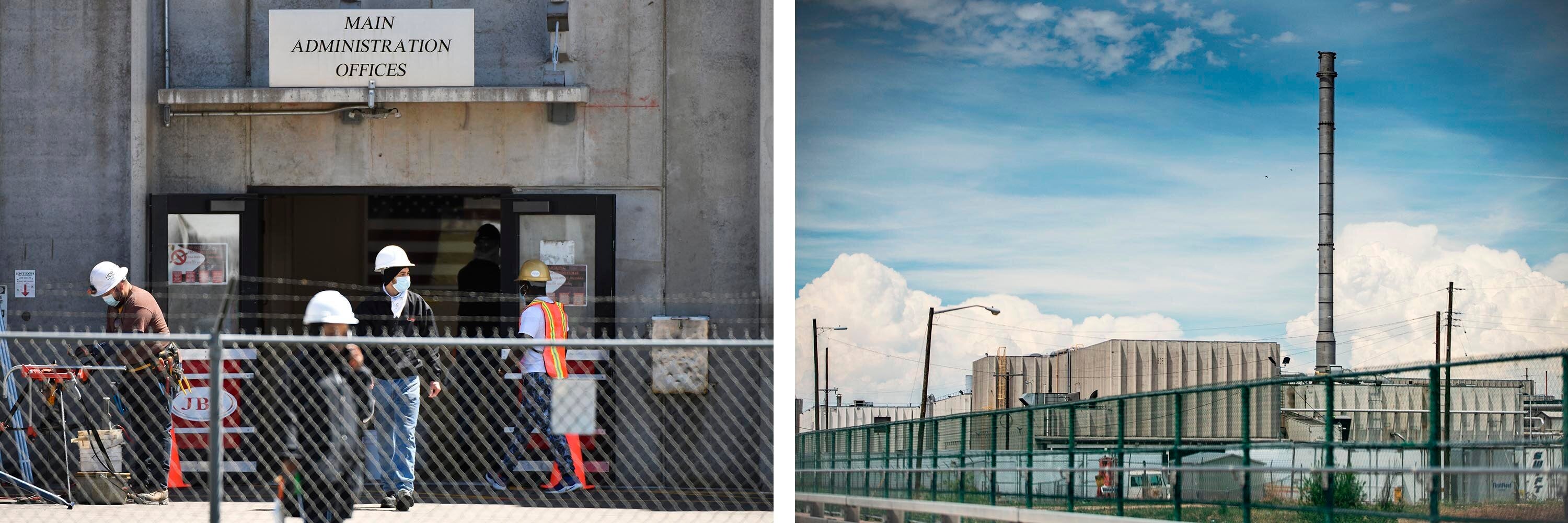
The sheer size of today’s meatpacking facilities makes them “perfect incubators for the spread of a virus like this,” said Douglas. In an industry intent on efficiency, workers stand shoulder to shoulder for hours in wet and unventilated areas. They share bathrooms, cafeterias, and sometimes housing and transportation.
It didn’t take long for the U.S. meat industry to reach a breaking point. Cases surged, plants closed, and suddenly the U.S. was facing shortages. By May, 1 in 5 Wendy’s fast-food restaurants was completely out of beef.
“That even one facility with 3,000 workers shutting down for a week could have a demonstrable effect on the national food supply,” said Douglas, “That was startling to a lot of people.”
The impact of COVID-19 on America’s food system is a wake-up call. A near-direct result of humanity’s destruction of nature — most notably increased levels of deforestation, pollution and habitat ruination — the pandemic can be seen as a warmup, not just for future disease outbreaks, but for the intensifying climate crisis that threatens the systems we rely on to survive.
For all the consumer-facing, shrink-wrapped elegance of the modern food system, the pandemic has exposed its fragility.
Alongside the public health crisis, poverty and food insecurity have skyrocketed this year. As of July, 29 million Americans said they “sometimes or often” did not have enough to eat.
At the same time, Americans were confronted with images and stories of farmers forced to dump milk, destroy crops, and euthanize their livestock as processing facilities and restaurants shut down.
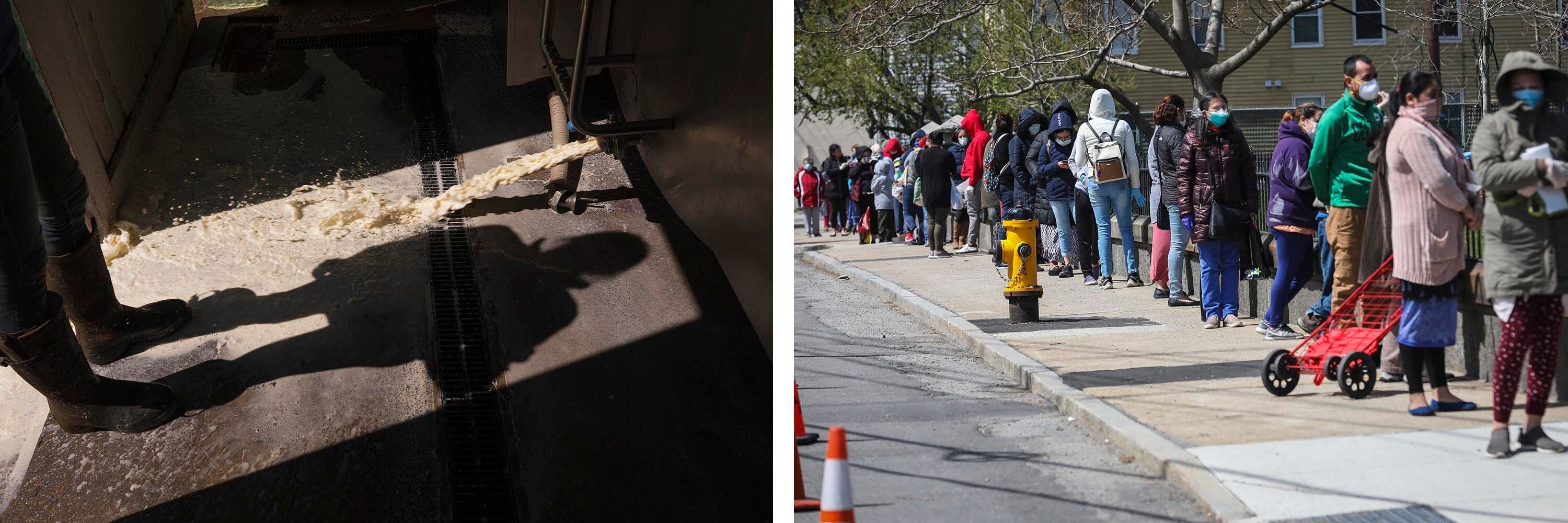
These contradictions between food waste and hunger, said Phil Howard, a social scientist and professor at Michigan State University, are a result of an industrial food system “really designed not to feed people” but rather “to increase the power of a few dominant firms.”
For the last two decades, Howard has studied the consolidation of the food system. He’s documented large companies gobbling up smaller ones, mergers between corporate powerhouses, increased foreign ownership, and deceptive marketing that obscures the trend of monopolization.
Today, six companies control two-thirds of the U.S. meat supply. Whereas meatpacking workers once earned relatively high wages, the last four decades have seen a chipping away of wages and workplace safety protections for an often exploited workforce, largely made up of immigrants and workers of color.
Of course, it’s not just meat, and it’s not just the U.S.
Every part of today’s global food chain — from seeds and farm equipment to the supermarket shelf — is affected by the trend of corporate consolidation. More than 60% of global seed sales, for example, are made by just four companies.
We have been led to believe that Big Agriculture is the most efficient and effective way to feed a growing population, but this argument ignores the damage it does. It’s a heavily subsidized social and environmental liability.
Because a handful of companies control markets, farmers are seeing incomes fall as they are forced to pay higher prices for inputs and accept lower prices for the products they grow. Globally, farmers are also losing agency over their own farms, as corporations increase control of production through predatory contracts.
The environmental costs are enormous. Pollution, greenhouse gas emissions, and the fragmentation of natural landscapes are increasing. Fertilizer runoff drains from the Mississippi River into the Gulf of Mexico, creating gigantic “dead zones.” Thousands of square miles of Brazil’s Cerrado — considered the most biologically rich savanna in the world and a huge carbon sink — have been cleared for sprawling soy plantations, the vast majority for animal feed. Habitat loss is a key contributor to zoonotic diseases, such as COVID-19, that spread from wild animals to humans.
All the while, industrial farming practices destroy the soil on which they rely, requiring more fertilizer and more land.
Industrial agriculture wants us to believe that “feeding the world” is a one-size-fits-all problem, requiring increased production to feed a growing population. But as we charge headlong into an uncertain future, truly feeding the world will require uprooting deep-seated institutions of power, and embracing diverse methods of food production that work with local ecosystems, not against them.
Looking to Indigenous agricultural practices informs part of the path forward, as does deploying newer low-impact farming practices. Farmers and scientists all over the world have direct experience in creating more equitable, ecologically sound food systems.
The rolling green hills of Chianti are dotted with vineyards. The Italian region sends about 70% of its famous red wine around the world. But, in common with many other export-oriented agricultural regions, there are few farmers in Chianti growing foods that people in the area can actually eat. Lorenzo Costa is trying to buck this trend.
He is the only farmer in the town of Gaiole — in the heart of the region, Chianti Classico — who is not growing wine grapes. Costa’s 22-acre farm slopes with 300-year-old terraces, planted with 18 different crops, including lentils, potatoes, olives and saffron. His products, purchased by neighbors and local chefs, often don’t travel farther than 10 miles, and he says that’s the point. Although Chianti Classico is an agricultural region, it produces almost no table foods.
For Costa, his product diversity is his strength. When Italy shut down early in the pandemic, he heard stories of large farms losing their single crops, due to lack of market or labor.
“What we saw during COVID was that the farms that work in a monocultural way had problems,” said Costa, whereas more diverse operations like his, which market directly to the consumer, were better able to withstand the crisis.
In general, local and regional food networks and shorter supply chains have been less disrupted by the pandemic, said Howard. And smaller farmers, processors and retailers have been able to weather these tenuous months better than their big-box counterparts — due in part to having “more flexibility and the ability to shift quickly.”
Lack of flexibility poses significant risk. Take again the example of U.S. meatpacking plants. To stop the spread of COVID-19 among meatpacking workers, Douglas said, structural change is needed: fewer workers and slower line speeds. But meatpacking facilities are inherently rigid and output-oriented, and Douglas said that even in a crisis, “there’s not that margin for slowing down the line, even though we know it is probably the most important thing that could be done.”
Industrial agriculture’s insistence on so-called efficiency has led also to a casualty of diversity: huge regions being transformed into monocultures — miles upon miles of a single commodity crop. Almost half the world’s farmland is now dedicated to just four crops: soybeans, wheat, rice and corn.
On the one hand, these commodity crops are staple foods for the majority of the world’s population and a vital part of the global food system. But industrial monocultures often require chemical inputs that degrade the soil, reduce biodiversity and endanger workers. As many as 25 million agricultural workers are estimated to experience pesticide poisoning each year.
“Monocultures are disastrous for long-term food security,” said farmer and scientist Debal Deb, who founded the world’s only open-source seed bank for heirloom rice. And history reminds us of their risks. During Ireland’s Great Famine in the mid-1800s, about 1 million Irish people starved after the country’s potato crop was overtaken with blight. The problem? A single potato variety that proved susceptible to disease.
It’s a history we’re at risk of repeating. A deadly fungus is currently infecting banana plantations around the world, for instance. And because more than half of bananas grown globally are of just one variety ― the Cavendish ― widespread disease potential puts the global banana supply, and the communities economically dependent on the banana industry, at serious risk.
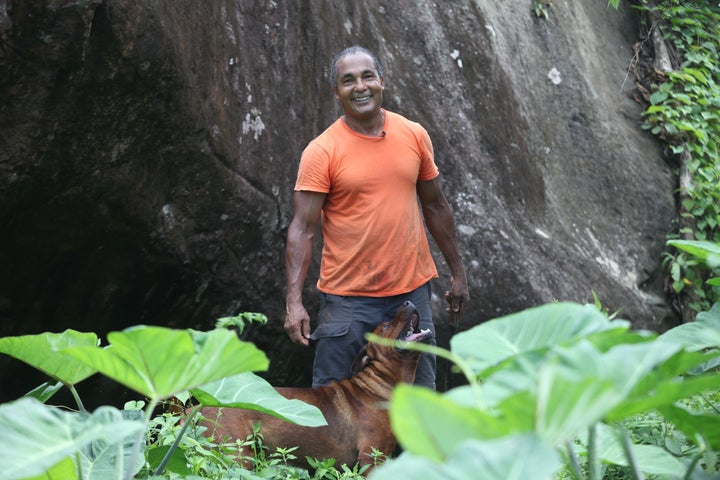
Nichie Abo, a warrior of the Kalinago tribe, on the island of Dominica, understands well the risk of relying on one crop — and the importance of maintaining diversified food production and knowledge, even in communities where export-dependent cash crops are important.
Dominica’s volcanic terrain has made it difficult to support commercial agriculture, with the exception of the banana industry in the 1970s and ’80s, which thrived until the “banana wars” of the 1990s when the Clinton administration sued the European Union, claiming it was giving unfair trade advantages to the island. The EU lost and commercial banana production largely disappeared from Dominica, said Abo.
With the loss of the banana industry went the main source of employment, so islanders returned to traditional methods of food production. Residents now grow enough to feed their own families and sell any surplus to markets on Dominica and neighboring islands. Today, more than 3,000 Kalinago tribal members still live close to the land, fishing and practicing subsistence agriculture. “I can essentially survive by just walking out to my garden,” said Abo, rattling off the foods directly around him: cassava, taro, coconut, breadfruit, mango.
Abo has followed news stories about buckling food chains in Europe and the United States. “It’s pathetic, really,” he said. The industrial food system is “driven by people who have made money and they’re in a position to manipulate the system so they can continue to live lives that are unimaginable to people like myself … and at the same time, they’re destroying the planet.”
The island might be “materially poor,” said Abo, but the lifestyle of the Kalinago people is fundamentally resilient. When Hurricane Maria devastated the island in 2017, homes were destroyed, but the community was never without food. There were still tubers in the ground and fish in the ocean.
For Abo, bringing food back to the local level was the way for the island to regain control. To build a resilient community, Abo said, “create a community that can feed itself.”
At the 1996 World Food Summit, the term “food sovereignty” was coined by international peasant rights organization La Via Campesina. While the concept is generally defined as a people’s right to control the food they produce and eat, food sovereignty is also a movement. Led by smallholder and landless farmers and those most affected by land grabs, poverty and hunger, the food sovereignty movement stands in direct opposition to the top-down models employed by corporate agribusiness.
Food sovereignty is rooted in the struggles for justice and equality, said Elizabeth Mpofu, a farmer and general coordinator for La Via Campesina. Women produce 40% of the world’s food, yet they own less than 20% of land — a disparity that Mpofu has experienced personally. It was not until Zimbabwe’s government land reform in 2000 that Mpofu was able to own land in her own name, instead of her husband’s.
While Zimbabwe’s land reform aimed to address the racism that concentrated land in the hands of white farmers, it has also been blamed for increased rates of poverty and for famine. But for Mpofu, being able to farm her own land resulted in enormous changes to the food security of her community. Land once held by just six white farmers is now being cultivated by 320 Black Zimbabwean farmers. Food is traded and shared between families, and any excess is marketed.
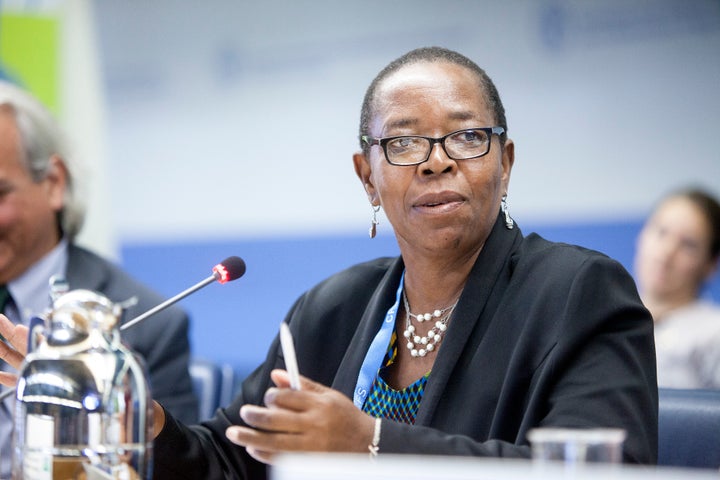
Today, Mpofu grows vegetables, ground nuts and grains without irrigation on nearly 25 acres in Masvingo Province — one of the driest parts of Zimbabwe. She raises goats, pigs and chickens for meat. She produces all of her own food, except for staples that she purchases, like sugar and salt.
And yet, across the Global South, said Mpofu, corporations and foundations continue to impose the use of expensive new technologies, genetically modified seeds, and chemical fertilizers and pesticides onto small-scale farmers. Such entities maintain that the “farming system that we are doing is not able to feed the nation,” Mpofu said in a podcast interview. “That is totally a lie.”
About 70% of the world’s food is produced by smallholder farmers on just 19% of cultivated land, said Loren Cardeli, the founder of the nonprofit A Growing Culture. “When we let that statistic soak in, we can’t help but wonder — how do industrial farming systems get credit for feeding the world? Who is more efficient? Who is more adaptable?”
While COVID-19 has certainly increased consumer interest in small farms and local food, there are limitations. One of the very characteristics that help make smaller, diversified farms so resilient — their size — can also be an economic disadvantage.
It’s a challenge Chris Newman, a Black-Indigenous farmer in Virginia, has set out to tackle. Newman, who runs Sylvanaqua Farms, which sells meat and eggs throughout the Chesapeake Bay region — argues that most independent small-scale farms aren’t viable.
“If you’re going to compete with Big Ag, you have to compete as a large entity,” Newman said in an interview. “And you’re just not going to do that with a million independent farms all doing their own thing.”
He proposes a different model, where producers combine their resources to produce food “regeneratively, responsibly, and ethically.” Newman imagines small-scale farming collectives operating at a regional scale and owning the entire supply chain: “from nursery and hatchery, to farms and processors, to distribution and the market endpoints themselves.” This would allow them to keep prices affordable, he said, while minimizing negative environmental impact.
Currently Sylvanaqua Farms is actively managing livestock on 120 acres of a 1,900-acre property. “We’re basically an ex-family farm in the middle of a transition to a collective,” said Newman, trying to address multiple major food system problems simultaneously: “making sure that [farmers] are compensated fairly and making sure that we get labor exploitation out of the farming system … and actually making the products of regenerative agriculture accessible to people who are not just the 1%.”
At scale, Newman — who is an enrolled member of the Choptico Band of Piscataway Indians — said it’s possible to combine the realities of the market with large-scale Indigenous land stewardship. It’s a way of looking after the land that acknowledges interdependence with the Earth, said Newman. “Even the word for ‘farmer’ in my language, ehakihet, means a person who is in the ground. You can’t describe someone who’s a farmer without also describing them as a land protector.”
We are peppered with solutions for fixing the food system, from lab-grown burgers to flashy apps built by tech startups and venture capitalists — but there’s plenty of reason to be skeptical. What are portrayed as simple, silver bullet solutions, said Howard, are in fact ways “to steer the conversation, in order to avoid dealing with all these complex social, political and economic issues.”
Cardeli agrees and said that without upending the power and profit in our food and agriculture systems, any single “solution” rings hollow.
Decreasing corporate control over the food system and democratizing production requires political action, something that has been relatively rare in recent years.
But there are exceptions. In the United States, ground zero for corporate agriculture, the call to “break up Big Ag” has reached the federal level. Democratic Sen. Cory Booker (N.J.), for example, has responded to grassroots movements by introducing bills that would prevent future mergers, hold polluting agribusinesses accountable, and help farmers transition away from industrial livestock operations.
Howard said that while such legislation raises awareness, he is generally not optimistic about policy change. “The [U.S.] government, since the 1980s, has really reinforced these trends and made things much worse,” he said. Antitrust laws have been reinterpreted so dramatically by federal judges that they have little bite, added Howard, and “they’re actually only reinforcing the power of these big firms.”
Howard also pointed to the crucial need to reform subsidy systems around the world, which help prop up industrial agriculture. In the U.S., between 1995 and 2020, 78% of commodity subsidies (nearly $188 billion) went to the top 10% of recipients.
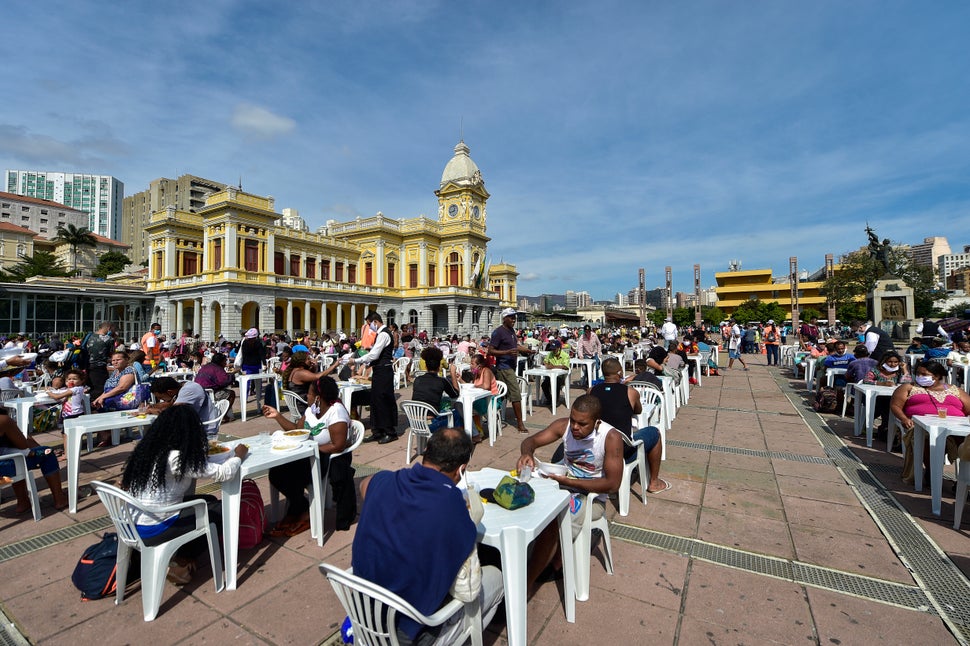
Beyond federal legislation, progress can be achieved at the municipal level, as proved by the Brazilian city of Belo Horizonte, which in 1993 guaranteed the right to sufficient, quality food for the city’s 2.5 million residents. Using just 2% of the city’s annual budget, it has implemented nearly 20 programs to tackle food security, including agroecology training and community gardens, the establishment of subsidized People’s Restaurants — where all residents can eat for less than $1 — and a network of small-scale farms selling directly to the consumer.
Since the program was implemented, the city has seen a huge reduction in malnutrition, as well as a 70% decrease in infant mortality and a big increase in consumption of local and organic food. As of 2019, more than 31,000 tons of affordable, healthy food has been provided to residents and 37 community food systems have been implemented.
Movements calling for climate action could also bring about agricultural reforms. President-elect Joe Biden has promised to include incentives for farmers as part of his climate action plan when his administration takes over in January 2021 — although it’s unclear how much he’ll be willing to push. Globally, investors and lenders are also adding pressure on agribusinesses to show they are tackling climate change. In June, seven huge European investment firms warned they would divest from beef producers, grains traders and even government bonds in Brazil if action wasn’t taken to stem surging deforestation in the Brazilian Amazon.
“When the food system is merely working normally, it is centrally responsible for climate change, ecosystem degradation and fatal levels of pollution. When it goes wrong, it incubates new and lethal diseases in the petri dishes of animal feedlots,” author Raj Patel wrote in his book “Stuffed & Starved.” “[The] food system is a machine gun generating new threats as part of its routine operation.”
We have, unfortunately, witnessed that machine gun at work repeatedly over these last eight months. If COVID-19 was a test, the food system failed. The urgency is only growing, as increased poverty, ecological disasters and global public health crises threaten food security in lockstep with the climate crisis. Continuing the status quo is likely to endanger global food supplies, reduce crop yields, make food less nutritious and drive up prices.
Much like agricultural monocultures, the food system is dominated by a stagnant and often harmful monoculture of ideas. But there are other ways to farm, process and distribute food, and it is by listening to a multitude of global voices that we unearth new paths forward.
After decades of unchecked expansion of the industrial food system, we’ve suffered inordinate losses: age-old farming practices, mentorship and skill sharing, water and soil health, the well-being of our families and neighbors, and food security.
For all of its power and might, said Abo, the industrial food system is missing something intangible, yet fundamental: “reverence for plants, for water, air, all of the things that sustain us.”
CORRECTION: This article erroneously listed Smithfield as one of four companies that control U.S. beef production. Smithfield does not produce beef.